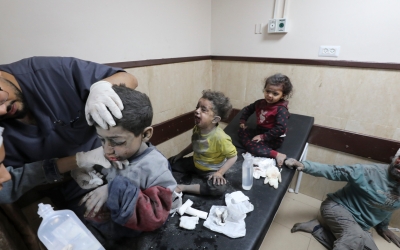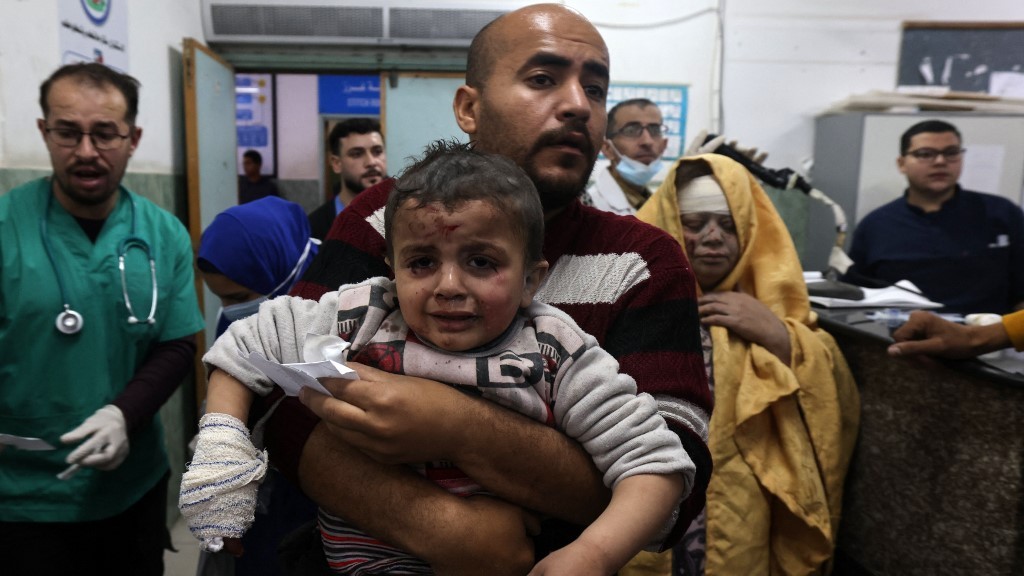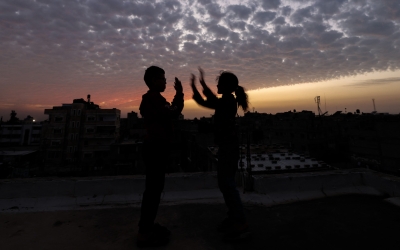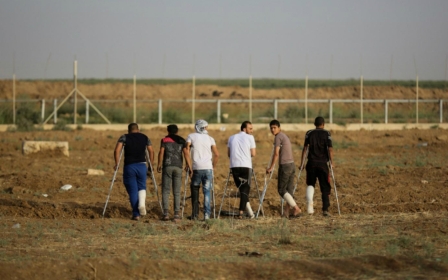UK denies medical treatment to critically injured children from Gaza
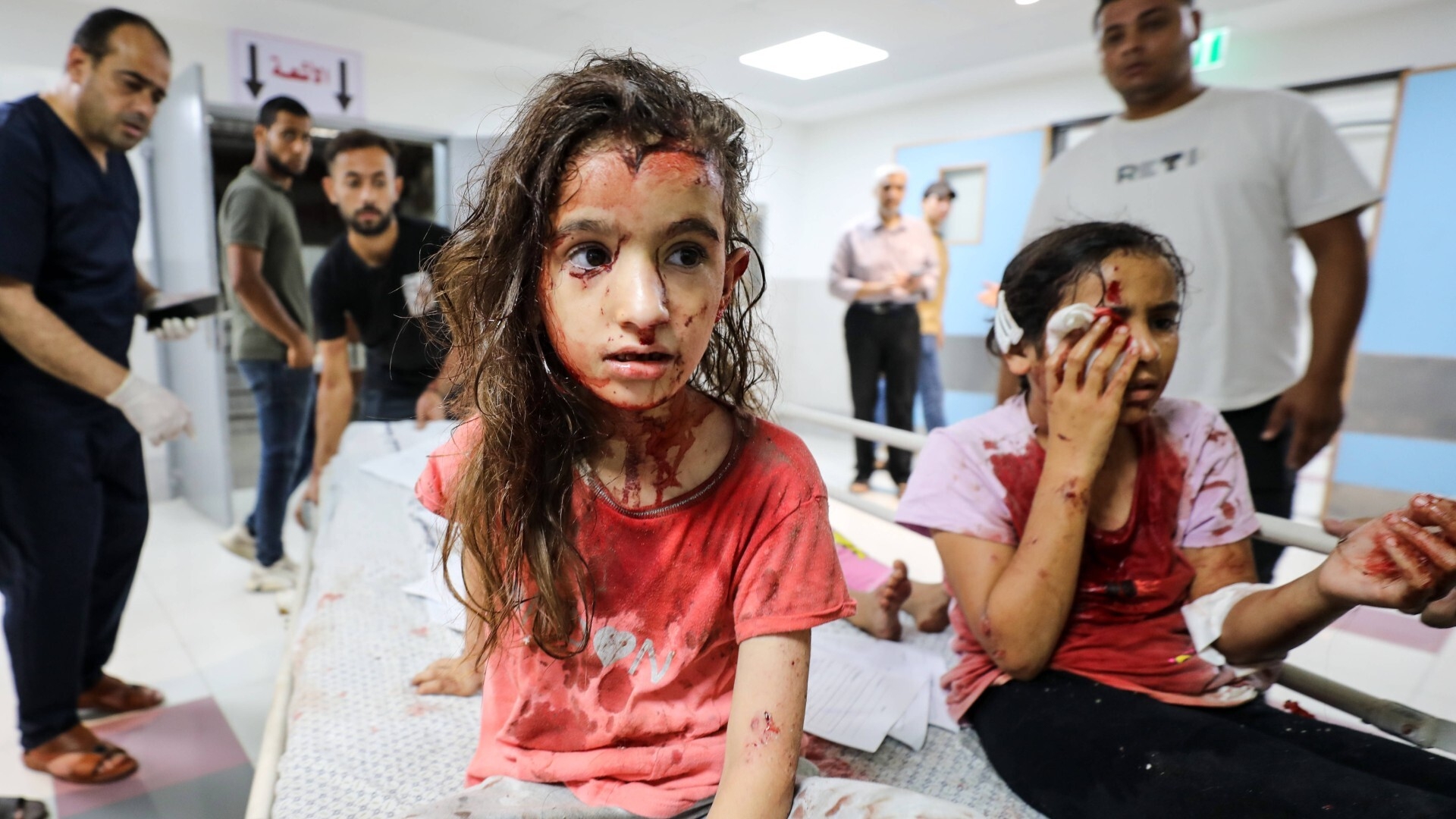
A nine-year-old girl, whose home was bombed, suffers from broken bones along her right side and gaping open wounds down the left.
A four-week-old, shot in the head by a quadcopter while breastfeeding at seven days old, now has daily seizures.
A 14-year-old, shot in the pelvis while trying to flee combat, has sustained internal damage to his organs.
These are three Palestinian children among thousands whom medical professionals and NGOs say need to be evacuated for specialist treatment, which is no longer available in Gaza’s devastated healthcare system.
The relative few who have been able to get out for treatment have ended up in Qatar, the United Arab Emirates, Turkey, Italy, France, Malta and the United States, among other countries.
But not the United Kingdom.
“We have not asked the UK to take all of them or the majority of them, but just to play its part as a wealthy nation with incredible medical expertise,” said Krish Kandiah, founder of the UK-based Sanctuary Foundation, which supports Ukrainian and Afghan refugees, among others.
“We just want to play our part.”
British doctors and organisations, including Kandiah’s, who are part of an initiative called Project Pure Hope, told Middle East Eye that they began efforts in January to bring four siblings and their cousin from Gaza as a "test case" to see what would happen.
One of the siblings, whose parents were killed, had suffered traumatic amputations and required further medical treatment, which pediatric hospitals across Britain were prepared to provide.
Over £500,000 ($636,000) was raised, enough to cover their treatment, and arrangements were made for the children’s aunt and grandmother to accompany them, according to those involved.
The issue was visas.
“We made many, many attempts to try to get a visa for these children and, sadly, despite many good-hearted civil servants, when it got to the highest level, we just heard nothing back,” Kandiah told MEE.
Five months later, with British hospitals and medical professionals still at the ready, Kandiah and others say they are unaware of any legal pathways available to bring these children to the UK, nor have they heard of any Palestinian children seeking medical treatment being admitted.
They point to the care Malala Yousafzai, the Pakistani campaigner for girl’s education, received at a Birmingham hospital after she was shot by a Taliban gunman and, more recently, Ukrainian children with cancer whom the National Health Service (NHS) brought to England in 2022 for treatment, along with their family members.
“We literally were asking to bring a handful of children,” said Dr Omar Abdel-Mannan, a British-Egyptian paediatric neurologist and founder of Health Workers for Palestine.
Abdel-Mannan has worked at Great Ormond Street Hospital in London, one of the world’s leading facilities treating children, during a time he said upwards of 100 Ukrainian children were being treated.
“The double standards are very clear for anyone to see. I’m sad to see my own NHS, which is helping patients day in and day out, is unable to do this, not because of [a lack of] willpower from medics, but at a political level,” he said.
'The double standards are very clear for anyone to see'
- Dr Omar Abdel-Mannan, paediatric neurologist
MEE asked the Home Office and Foreign Office about the five children and, more broadly, why the government has not allowed Palestinian children into the country to receive care and whether there are any plans to do so.
The Foreign Office did not respond. A Home Office spokesperson said people seeking private medical treatment in the UK could apply for a temporary visa, although MEE understands that biometrics, which are no longer available in Gaza, have been required.
"All applications are considered under their own individual merits and in accordance with immigration rules,” the spokesperson said.
'Totally salvageable injuries'
If you reach out to NGOs and doctors working to evacuate children from Gaza for medical treatment, they will describe an overwhelming situation where the scale of need far exceeds the ability of any single country or organisation to provide a solution.
“If you could hear my WhatsApp - the voice messages I get, the calls,” said Dr Tareq Hailat, who heads the treatment abroad programme for the US-based Palestine Children’s Relief Fund (PCRF). “People are begging and pleading consistently to receive help.”
In the UK, Somaya Ouazzani of the NGO Children Not Numbers said she and her co-founder, Sarah Ben-Tarifite, wake up most mornings with messages, particularly from mothers, seeking help.
“I will wake up at five in the morning with someone who has got my number from a desperate family member in Gaza with photos of their child in a body bag saying: ‘I’ve only got this one child left. Please evacuate them’,” she told MEE.
“Or: ‘This is my dead husband. He was a nurse at this hospital. We’ve got our daughter left. Please help'.”
More than 14,000 children have been killed in Gaza since October, according to the latest statistics from the Palestinian health ministry.
However, these figures do not include children who have died from conditions developed as a result of injuries sustained in bomb blasts or air strikes, or from lack of access to medical treatment.
For example, many children in Gaza with burn injuries are dying from sepsis, an extreme reaction to infection that can lead to organ failure.
'What about the children that have legs, arms, fingers, their intestines blown out of their body? These are treatable conditions'
- Somaya Ouazzani, Children Not Numbers co-founder
Without enough antibiotics and other medications, NGOs say doctors are being forced to decide which children with burns are likely to live the longest and distribute medicine accordingly, leaving others to die from otherwise treatable wounds.
This was the case with a three-year-old girl who had burns across 30 percent of her body and died earlier this month after undergoing multiple organ failure, Ouazzani said.
Ouazzani added that other children are dying from renal failure and kidney disease because medications and treatment, particularly dialysis, are not longer available.
“The UK might say this is a chronic condition and, if you bring a child over that requires dialysis, the reality is they are going to need dialysis forever, so why would we bring them here for a period only to go back to Gaza?” Ouazzani said.
“We hear that. But what about the children that have legs, arms, fingers, their intestines blown out of their body? These are treatable conditions.”
Others, she said, are dying from the conditions of the war, not resulting in injuries. For example, three-year-old Osama was frightened when he heard a bomb blast and ran into a tent where his mother was boiling water. He suffered 60-degree surface area burns.
"The doctors kept him alive for 14 days and then he died," Ouazzani said. "He would have survived if he had been evacuated but the Rafah crossing closed the day before we got him approval to leave."
This, she said, is the case for many of the children who have died in recent weeks: they had “totally salvageable injuries”.
Children in pain
Tess Ingram is a communications specialist with Unicef, the UN's children's agency. She visited Gaza in January and again in April, and she met quite a few children who had lost limbs as a result of shrapnel wounds that weren’t treated effectively and had become badly infected.
“And then, that amputation, maybe it’s not performed under the best conditions given the circumstances, and so the child has continued to have pain or infection or some other ongoing challenge with that injury,” Ingram said.
In January, she met Ibrahim, a child whose arm had just been amputated after a shrapnel wound had turned gangrenous. His mother was trying to get him evacuated for medical care.
Three months later, Ingram happened to run into Ibrahim while visiting the Gaza European Hospital near Khan Younis in the south. “His mom was still trying to get him medevacked, and he had become sick and weak,” she said. “They weren’t really sure what was happening.”
Ingram said she was struck during her recent visit by the sheer number of injured children, more so than in January, in hospitals and on the streets, unable to receive the care they needed and languishing in pain.
“The doctors in the hospital are doing miraculous work with the limited staff and resources and the danger that they are in,” she said.
“To me, the problem here is the lack of medical evacuations. When children are in this condition, they need to be able to leave to get the medical care that they require and that is not happening.”
Evacuation requests rejected
Getting out of Gaza for treatment was a logistical nightmare even before the Rafah crossing on the Egypt border - the only way out for medical evacuations - was closed earlier this month after Israel seized the facility.
To be evacuated from Gaza, patients must get a referral report from a medical professional confirming that the treatment they require is not available in the enclave. The report is then sent to Israel and Egypt, which has to approve each evacuation.
According to the World Health Organisation (WHO), 12,761 patients in Gaza had submitted requests for medical evacuations to Israel and Egypt as of 18 May. Only 46 percent were approved, including 4,895 who were evacuated.
'There are not enough hospitals or countries right now that are currently taking in patients'
- Dr Tareq Hailat, head of Palestine Children's Relief Fund
Among those figures, MEE understands, were 3,436 children who applied for medical evacuations, 2,175 whose requests were approved and fewer yet who were evacuated. Those involved say it is frustratingly unclear why some cases are approved while others are rejected.
Hailat estimated that more than 100,000 people overall will need to come out of Gaza for treatment.
Hailat said the PCRF has evacuated and treated the most children of organisation working in Gaza. It has successfully evacuated more than 100 children, sending over 70 of them from Egypt to other countries for proper treatment.
“That’s really nothing if you are thinking about it in the larger scheme of things,” he said.
“There is just an incremental amount of patients that need help and there are not enough hospitals or countries right now that are currently taking in patients.”
In addition to countries which have already taken patients, Hailat said PCRF is now looking to expand to Jordan, South Africa and Algeria, hoping more European countries will also come on board.
“We’re trying really all our avenues because there is such a large amount of children that need the care,” he said.
“If the US is taking in children, then the UK should definitely be doing the exact same thing. The US has now accepted 20-plus children at least for treatment. The UK, with its expertise and its proper medical care facilities, it seems to be something that should be done.”
Ouazzani said Children Not Numbers, which first identified the case of the four siblings and cousin who ended up in the UAE after UK visas failed to come through, has over 250 children on their database awaiting evacuation, which will take a minimum of six months to clear.
“Italy has been incredible. It has taken many children. Belgium has indicated a desire to help. France, I think, has already accepted a handful. Germany has started indicating that it will. Turkey has taken many. Spain has started to investigate the possibility of doing so,” she said.
“But the UK - which has some of the best paediatric services in the world, some of the best plastic and reconstructive services in the world - has utterly failed. It is an abomination.”
'Never say never'
MEE understands that earlier this year senior Foreign Office officials suggested to aid workers that evacuations to the UK were unlikely and that the government could facilitate more field hospitals in Gaza or send more doctors instead.
The first UK-funded field hospital opened near Rafah in March, but it can only provide urgent care, not the ongoing or specialist treatment many children require.
British MPs and peers have pressed the government this month to reconsider its position.
“Children are still being killed and mutilated, yet we provide no assistance to allow those children access to health facilities beyond Gaza itself,” Labour MP John McDonnell said in a 13 May debate.
“The least the government could do is ensure that there is an effective evacuation scheme for injured children.”
Two days later, Baroness Armenika Helic, who helped Malala Yousafazai get treatment in the UK, asked whether the government would consider “a pathway open for children with serious wounds so they can be given specialist care which only can be afforded to them in specialist hospitals which we are lucky to have in this country”.
Middle East minister Tariq Ahmad said the UK had worked with the UAE and Egypt to help the most acute cases to be evacuated and stated that the government wanted to ensure that those with the most urgent needs, particularly children, were provided support.
“But I add again, the best way we can achieve this, and I say it again, and I will say it time and time again, we need to stop the fighting. We need to get the aid in. We need to ensure all the facilitation of all the medical services and also get the hostages out,” he said.
“Human suffering does not look at religion, race, colour or any other creed... we must put humanity at the core of everything we are doing.”
He visited Qatar the following week, during which he presented a new British-Qatari partnership to help Palestinian patients evacuated from Gaza to the Gulf emirate.
With the general election announced for 4 July comes the prospect of a new government with a different take on Palestinian medical evacuations to the UK.
Kandiah said that even though getting five Palestinian children to the UK proved to be impossible, he has yet to give up.
“There are days when I wonder whether we will ever help any [Palestinian children], but then I think back to 2015 when the UK was very adamant that we weren’t taking any Syrian refugee children,” he said.
He said it sadly took the death of Alan Kurdi, the three-year-old Syrian boy from Kobani whose body washed up on a Bodrum beach after the dinghy his family was on capsised, to shift the opinion of the government, led at the time by David Cameron.
“So, I never say never,” he said.
Middle East Eye propose une couverture et une analyse indépendantes et incomparables du Moyen-Orient, de l’Afrique du Nord et d’autres régions du monde. Pour en savoir plus sur la reprise de ce contenu et les frais qui s’appliquent, veuillez remplir ce formulaire [en anglais]. Pour en savoir plus sur MEE, cliquez ici [en anglais].




